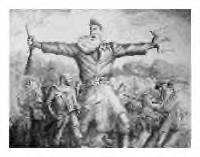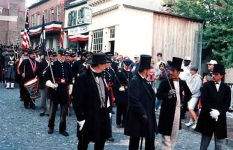Sponsor this page for $75 per year. Your banner or text ad can fill the space above.
Click here to Sponsor the page and how to reserve your ad.
-
Timeline
Detail - 1853
April 22, 1853 - The Indian Frontier Post, Fort Scott, in Indian Territory (Kansas) is evacuated by the United States Army riflemen.

Fort Scott would serve many functions throughout its history, built in 1842 for namesake General Winfield Scott, and needed as a supply base along the Santa Fe Trail. However, its main function, it would turn out, would be to suppress rebellion, by both the tribal nations of the area as well as the settlers. And the odd thing is, this event, the evacuation by the Army on April 22, 1853, would be short lived and foolish. As Fort Scott would be needed again and again through the trying times of Bleeding Kansas through the Civil War.
However, for an eleven year period from 1842 to 1853, it was the fort that kept the peace between tribes to the west and settlers to the east. That was the official policy. When it came time to change the policy as more settlers wanted, or were taking, land in Kansas, the fort was abandoned, no longer needed for its original purpose. Kansas and Nebraska were now open to white settlement. That was now official policy. The dragoons, mounted infantry who dismounted to fight and infantry soldiers left the fort, leaving the town around it to now become just that, a white settlement.
However, the first decade as a civilian town corresponded with "Bleeding Kansas" and the battles between pro-slavery and anti-slavery forces. This occurred for seven years (1854-1861) with civil disturbances in the town of Fort Scott and many others per John Brown and his compatriots. Fort Scott itself was a pro-slavery town, headquartered in the Western or Pro Slavery Hotel across from the fort parade grounds; the countryside against. Eastern Kanasas became a particulary rabid area in the debate as Kansas and Nebraska citizens would eventually vote on who would be free or pro-slavery. Fort Scott, the town, grew to six hundred people, and many bought the buildings of Fort Scott. And yes, supported by followers of Brown, and local leader James Montgomery, they had their own hotel, the Free State Hotel. It is thought that the Marals des Cignes Incident was formulated in the Western Hotel. On May 19, 1858, eleven free staters were massacred forty miles north of Fort Scott. Later, a gang of free staters raided the town in daylight, killing the opposition as they left, and in December 1858, Montgomery rescued a fellow free state advocate who he said had been inaccurately imprisoned for murder. During this incident, Deputy Marshall John Little, who had shot into Montgomery's crew, was subsequently killed.

Construction of Fort Scott and Use Prior to 1853
There was a need for a fort just west of the Missouri border after the population boom that saw 12 million people in the Census of 1930, many heading west. Missouri had become a state in 1821, and Kansas was now part of the hard to define and swiftly gone "Permanent Indian Frontier." It had originally been the territory of the Osage; five thousand were moved west to "Indian Territory," during this frontier period. A series of forts were built; Fort Snelling (Minneapolis) to Fort Jesup (Louisiana), Fort Smith (Arkansas), and Fort Leavenworth and Fort Scott (Kansas). For Fort Scott, its main mission, keep white settlers out of Kansas, and keep the Osage out of Missouri. Named for U.S. General Winfield Scott, General in Chief of the U.S. Army, it was established on May 30, 1842 as a staging ground and safe haven, as well as a stop along the Santa Fe Trail. The first troops there were two companies of the First United States Dragoons. They would patrol a vast amount of territory during the 1840's along the Santa Fe and Oregon Trails, even scuffling with Texians prior to the permanent drawings of territory boundaries and the inclusion of Texas into the United States.
The site chosen was good, on a bluff overlooking the Marmaton River. The area had plenty of water, lumber, food, and coal for fuel. The buildings were situated around a three hundred and fifty foot square parade grounds; hospitals, officer quarters, stables, barracks, amongst others. When the War with Mexico began in 1846, most of the soldiers, except fifty, were sent to fight. Surprisingly, the fort continued to work well with its limited staff.
Fort Scott Reuse
After the Kansas-Nebraska Act passed, allowing Kansas to enter the Union as a free state in January 1861, soldiers came back to use Fort Scott during the Civil War. It was predominantly used as a supply center for battles in Missouri, Oklahoma, and Arkansas. The fort was also used to house the homeless, Army stragglers, and settlers on their way through the territory. As part of its history during this time, the First and Second Kansas Colored Volunteer Infantry Regiments were organized there, the first black troops in the Union Army. The First Kansas Colored Regiment was commanded by Colonel James Williams. After the battle of Wilson's Creek just ninety miles away, worry that the conflict would spread north and west brought great concern. Six thousand soldiers would be brought to Fort Scott to prevent the spread. It served as the headquarters of the Army of the Frontier, led by Major General James Blunt. Included in those troops were Colonel Phillip's battalion of Indian Home Guards.
The area was besieged by Confederate guerrilla attacks, including one by Confederate Cavalry officer William Quantrill, who ambushed a contingent of Union soldiers including General Blunt in October 1863. It is noted that only the speed of Blunt's horse made the difference in his escape. In October 1864, a Confederate raid of the town of Marmaton, several miles west, killed numerous citizens. A brief but vibrant battle occurred on October 25, 1864 when Confederate General Price, who had inflicted much damage during raids across Missouri, moved south. As he approached Fort Scott for supplies, General Alfred Pleasonton met the Confederates thirty miles north and defeated them.
After the Civil War ended, Fort Scott served during the period of railroad construction from 1869 to 1873. The Army returned, in part, to calm conflicts between land owners and claim jumpers.

Fort Scott National Historic Site
With the last vestiges of Army use of Fort Scott reaching back to 1873, it took until 1965 before the citizens of Fort Scott, along with the National Park Service, established the Fort Scott Historical Area. The area was originally owned by the City of Fort Scott. Since October 19, 1978, the National Park Service runs the site, which includes twenty historical buildings as well as tall grass prairie. Surviving buildings include four officer barracks, one dragoon barracks, two infantry barracks, hospital, guardhouse, stables, ordnance and post headquarters, bake shop, flagpole, and a magazine.
Visitation to the site is low, just 25,493 in 2023, so you'll have plenty of space, even though the site is small at under twenty acres, to wander around the site that tells an important story of the western frontier, the fight to end slavery, and African American service in the U.S. Army.
Image above: Visitors at Fort Scott's Officer's Quarters present day. Courtesy National Park Service. Below: Dragoon stables at Fort Scott National Historic Site, 2021, Carol M. Highsmith. Courtesy Library of Congress. Info source: National Park Service; Wikipedia Commons; Library of Congress; "Fort Scott Historical Area, Old Fort Historic Site," 1975, National Park Service; "Fort Scott (Kansas) is Founded," African American Registry.





